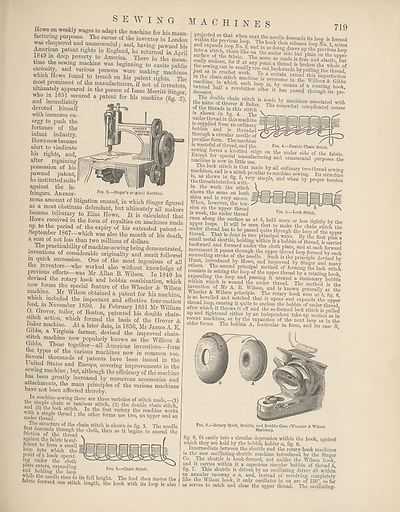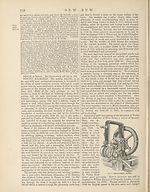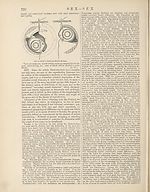Encyclopaedia Britannica > Volume 21, ROT-Siam
(729) Page 719
Download files
Complete book:
Individual page:
Thumbnail gallery: Grid view | List view

719
Howe on weekly wages to adapt the machine for his manu¬
facturing purposes. The career of the inventor in London
was chequered and unsuccessful; and, having pawned his
American patent rights m England, he returned in April
1849 in deep poverty to America. There in the mean¬
time the sewing machine was beginning to excite public
curiosity, and various persons were making machines
which Howe found to trench on his patent rights The
most prominent of the manufacturers, if not of inventors
ultimately appeared in the person of Isaac Merritt Singer
who in 1851 secured a patent for his machine (fig 2)
and immediately v '
devoted himself
with immense en¬
ergy to push the
fortunes of the
infant industry.
Howe now became
alert to vindicate
his rights, and,
after regaining
possession of his
pawned patent,
he instituted suits
against the in¬
fringers. Anenor- Fig. 2.—Singer’s original Machine.
mous amount of litigation ensued, in which Singer figured
as a most obstinate defendant, but ultimately all makers
became tributary to Elias Howe. It is calculated that
Howe received in the form of royalties on machines made
up to the period of the expiry of his extended patent—
September 1867—which was also the month of his death
a sum of not less than two millions of dollars.
. Practicabihty of machine-sewing being demonstrated,
inventions of considerable originality and merit followed
m quick succession. One of the most ingenious of all
the inventors who worked also without knowledge of
previous efforts—was Mr Allan B. Wilson. In 1849 he
devised the rotary hook and bobbin combination, which
now forms the special feature of the Wheeler & Wilson
machine. Mr Wilson obtained a patent for his machine,
which included the important and effective four-motion
teed in November 1850. In February 1851 Mr William
U. Grover, tailor, of Boston, patented his double chain-
stitch action, which formed the basis of the Grover &
Baker machine. At a later date, in 1856, Mr James A. E
Bibbs, a Virginia farmer, devised the improved chain-
stitch machine now popularly known as the Willcox &
Gibbs. These together—all American inventions—form
tne types of the various machines now in common use.
evera thousands of patents have been issued in the
l nited btates and Europe, covering improvements in the
sewing machine; but, although the efficiency of the machine
h-S i.6611 8’reatly increased by numerous accessories and
attachments, the main principles of the various machines
.have not been affected thereby.
s?win£> fllei'e are three varieties of stitch made,—-(1)
and /S.fT ?.rf tambour stitch, (2) the double chain stitch,
w tl, pc? i1 i Stl?h-, In the first variety the machine works
under thread*3 thread ’ th° other forms use two, an upper and an
firP!? Struc7url0f the chain stitcb is shown in fig. 3. The needle
cloth’then as ifc begfns to ascend the
SEWING MACHINES
neXTtttl’L”le?l' des“n,ls ita I“«II is formed
and expands loop Uo 2 and in snV . len1releases loop No. 1, seizes
into-a stitch, chain-like on ? S mrafS Up ^ previbus looP
surface of the fabric The «e nder ‘SUJe .)ut plain on the upper
easily undone Sr if at Inv S ^ 5™ and but
the sewing caA be readilvrmS h, lsubroken the whole of
just as in crochet work' TV, t backwards by pulling the thread,
in the chain-stitch machine is ni:ertaiu oxtent this imperfection
machine, in which each loon is e}iCOme 111 tb® Willcox & Gibbs
twisted half a revolution • ’ •P'A.meaTls °t a rotating hook,
decessor. c er lfc ias passed through its pre-
thJIlaine°of Grover11 fepSeS Tim by mfbines associated with
of the threads in this stitch somewbat complicated course
is shown in fig. 4. The \, „ , ^
under thread in this machine EJBM A •
is supplied from an ordinary
bobbin and is threaded
through a circular needle of
peculiar form. The machine
is wasteful of thread, and the Fig. 4.—Double Chain Stitch '
Excent a ki10tte<1 ridge 0n the under ^ of the’fabric
machine is nowTn liSlTuse^11118 and 0rnamental PurPoscs the
machines*3 an^is a stiteb * *7 a11 ordinary two-thread sewing
is as shown in fS rd PeCuh.ar \0 sewing. Its structure
the threads interlock vath-0? Simple’ and When by proper tension
in the work the stitch
shows the same on both
sides and is very secure.
When, however, the ten¬
sion on the upper thread
is weak, the under thread
Fig. 5.—Lock Stitch
™ a}0Ilg the surface as at b, held more or less tightly by the
upper loops. It will be seen that to make the chain stitch the
Zead That fsSdto0ibe-PafSed <1Uit8 th1r°Ugh the loop of tbe upper
inreaa. that is done in two principal ways. IW the first nlan n
small metal shuttle, holding within it a bobbin ofthread, is carried
backward and forward under the cloth plate, and at each forward
movement it passes through the upper thread loop formed by each
succeeding stroke of the needle. Such is the principle devised bv
Hunt, introduced by Howe, and improved by Singer and many
others The second principal method of forming the lock stitch
onsists m seizing the loop of the upper thread by a rotating hook
expanding the loop and passing it around a stationary liobbiii
within which is wound the under thread. The method is the
m” “Vh1?1' A' R W,ilson> “d “ k"°'™ ge„er2£ a, the
Wheeler & A ilson principle. The rotary hook seen at b, fig. 6
is so bevelled and notched that it opens and expands the upper
thread loop, causing it quite to enclose the bobbin of under thread
after which it throws it off and the so-formed lock stitch is pulled
up and tightened either by an independent take-up motion as in
recent machines, or by the expansion of the next loop as in the
older forms. The bobbin A, lenticular in form, and its case B,
Fig. C.—Rotary Hook, Bobbin, and Bobbin Case (Wheeler Wilson
Machine).
against the fabric is suf¬
ficient to form a small
loop into which the
point of a hook operat¬
ing under the cloth
plate enters, expanding
and_ holding the loop
Fig. 3.—Chain Stitch.
O
fabric V° nee?e ,dses V ips fuff height. The feed then moves the
abnc forward one stitch length, the hook with its loop is also
fig. 6, fit easily into a circular depression within the hook, against
which they are held by the bobbin holder a, fig. 6.
Intermediate between the shuttle and the rotary-hook machines
is the new oscillating-shuttle machine introduced by the Singer
Co. The shuttle is hook-formed, not unlike the Wilson hook,
and it carries within. it a capacious circular bobbin of thread Ji,
fig. 7. This shuttle is driven by an oscillating driver db within
an annular, raceway a a, and, instead of revolving completely
like the Wilson hook, it only oscillates in an arc of 150°, so far
as serves to catch and clear the upper thread. The oscillating-
Howe on weekly wages to adapt the machine for his manu¬
facturing purposes. The career of the inventor in London
was chequered and unsuccessful; and, having pawned his
American patent rights m England, he returned in April
1849 in deep poverty to America. There in the mean¬
time the sewing machine was beginning to excite public
curiosity, and various persons were making machines
which Howe found to trench on his patent rights The
most prominent of the manufacturers, if not of inventors
ultimately appeared in the person of Isaac Merritt Singer
who in 1851 secured a patent for his machine (fig 2)
and immediately v '
devoted himself
with immense en¬
ergy to push the
fortunes of the
infant industry.
Howe now became
alert to vindicate
his rights, and,
after regaining
possession of his
pawned patent,
he instituted suits
against the in¬
fringers. Anenor- Fig. 2.—Singer’s original Machine.
mous amount of litigation ensued, in which Singer figured
as a most obstinate defendant, but ultimately all makers
became tributary to Elias Howe. It is calculated that
Howe received in the form of royalties on machines made
up to the period of the expiry of his extended patent—
September 1867—which was also the month of his death
a sum of not less than two millions of dollars.
. Practicabihty of machine-sewing being demonstrated,
inventions of considerable originality and merit followed
m quick succession. One of the most ingenious of all
the inventors who worked also without knowledge of
previous efforts—was Mr Allan B. Wilson. In 1849 he
devised the rotary hook and bobbin combination, which
now forms the special feature of the Wheeler & Wilson
machine. Mr Wilson obtained a patent for his machine,
which included the important and effective four-motion
teed in November 1850. In February 1851 Mr William
U. Grover, tailor, of Boston, patented his double chain-
stitch action, which formed the basis of the Grover &
Baker machine. At a later date, in 1856, Mr James A. E
Bibbs, a Virginia farmer, devised the improved chain-
stitch machine now popularly known as the Willcox &
Gibbs. These together—all American inventions—form
tne types of the various machines now in common use.
evera thousands of patents have been issued in the
l nited btates and Europe, covering improvements in the
sewing machine; but, although the efficiency of the machine
h-S i.6611 8’reatly increased by numerous accessories and
attachments, the main principles of the various machines
.have not been affected thereby.
s?win£> fllei'e are three varieties of stitch made,—-(1)
and /S.fT ?.rf tambour stitch, (2) the double chain stitch,
w tl, pc? i1 i Stl?h-, In the first variety the machine works
under thread*3 thread ’ th° other forms use two, an upper and an
firP!? Struc7url0f the chain stitcb is shown in fig. 3. The needle
cloth’then as ifc begfns to ascend the
SEWING MACHINES
neXTtttl’L”le?l' des“n,ls ita I“«II is formed
and expands loop Uo 2 and in snV . len1releases loop No. 1, seizes
into-a stitch, chain-like on ? S mrafS Up ^ previbus looP
surface of the fabric The «e nder ‘SUJe .)ut plain on the upper
easily undone Sr if at Inv S ^ 5™ and but
the sewing caA be readilvrmS h, lsubroken the whole of
just as in crochet work' TV, t backwards by pulling the thread,
in the chain-stitch machine is ni:ertaiu oxtent this imperfection
machine, in which each loon is e}iCOme 111 tb® Willcox & Gibbs
twisted half a revolution • ’ •P'A.meaTls °t a rotating hook,
decessor. c er lfc ias passed through its pre-
thJIlaine°of Grover11 fepSeS Tim by mfbines associated with
of the threads in this stitch somewbat complicated course
is shown in fig. 4. The \, „ , ^
under thread in this machine EJBM A •
is supplied from an ordinary
bobbin and is threaded
through a circular needle of
peculiar form. The machine
is wasteful of thread, and the Fig. 4.—Double Chain Stitch '
Excent a ki10tte<1 ridge 0n the under ^ of the’fabric
machine is nowTn liSlTuse^11118 and 0rnamental PurPoscs the
machines*3 an^is a stiteb * *7 a11 ordinary two-thread sewing
is as shown in fS rd PeCuh.ar \0 sewing. Its structure
the threads interlock vath-0? Simple’ and When by proper tension
in the work the stitch
shows the same on both
sides and is very secure.
When, however, the ten¬
sion on the upper thread
is weak, the under thread
Fig. 5.—Lock Stitch
™ a}0Ilg the surface as at b, held more or less tightly by the
upper loops. It will be seen that to make the chain stitch the
Zead That fsSdto0ibe-PafSed <1Uit8 th1r°Ugh the loop of tbe upper
inreaa. that is done in two principal ways. IW the first nlan n
small metal shuttle, holding within it a bobbin ofthread, is carried
backward and forward under the cloth plate, and at each forward
movement it passes through the upper thread loop formed by each
succeeding stroke of the needle. Such is the principle devised bv
Hunt, introduced by Howe, and improved by Singer and many
others The second principal method of forming the lock stitch
onsists m seizing the loop of the upper thread by a rotating hook
expanding the loop and passing it around a stationary liobbiii
within which is wound the under thread. The method is the
m” “Vh1?1' A' R W,ilson> “d “ k"°'™ ge„er2£ a, the
Wheeler & A ilson principle. The rotary hook seen at b, fig. 6
is so bevelled and notched that it opens and expands the upper
thread loop, causing it quite to enclose the bobbin of under thread
after which it throws it off and the so-formed lock stitch is pulled
up and tightened either by an independent take-up motion as in
recent machines, or by the expansion of the next loop as in the
older forms. The bobbin A, lenticular in form, and its case B,
Fig. C.—Rotary Hook, Bobbin, and Bobbin Case (Wheeler Wilson
Machine).
against the fabric is suf¬
ficient to form a small
loop into which the
point of a hook operat¬
ing under the cloth
plate enters, expanding
and_ holding the loop
Fig. 3.—Chain Stitch.
O
fabric V° nee?e ,dses V ips fuff height. The feed then moves the
abnc forward one stitch length, the hook with its loop is also
fig. 6, fit easily into a circular depression within the hook, against
which they are held by the bobbin holder a, fig. 6.
Intermediate between the shuttle and the rotary-hook machines
is the new oscillating-shuttle machine introduced by the Singer
Co. The shuttle is hook-formed, not unlike the Wilson hook,
and it carries within. it a capacious circular bobbin of thread Ji,
fig. 7. This shuttle is driven by an oscillating driver db within
an annular, raceway a a, and, instead of revolving completely
like the Wilson hook, it only oscillates in an arc of 150°, so far
as serves to catch and clear the upper thread. The oscillating-
Set display mode to:
![]() Universal Viewer |
Universal Viewer | ![]() Mirador |
Large image | Transcription
Mirador |
Large image | Transcription
Images and transcriptions on this page, including medium image downloads, may be used under the Creative Commons Attribution 4.0 International Licence unless otherwise stated. ![]()
| Encyclopaedia Britannica > Encyclopaedia Britannica > Volume 21, ROT-Siam > (729) Page 719 |
|---|
| Permanent URL | https://digital.nls.uk/193636756 |
|---|
| Attribution and copyright: |
|
|---|---|
| Shelfmark | EB.17 |
|---|---|
| Description | Ten editions of 'Encyclopaedia Britannica', issued from 1768-1903, in 231 volumes. Originally issued in 100 weekly parts (3 volumes) between 1768 and 1771 by publishers: Colin Macfarquhar and Andrew Bell (Edinburgh); editor: William Smellie: engraver: Andrew Bell. Expanded editions in the 19th century featured more volumes and contributions from leading experts in their fields. Managed and published in Edinburgh up to the 9th edition (25 volumes, from 1875-1889); the 10th edition (1902-1903) re-issued the 9th edition, with 11 supplementary volumes. |
|---|---|
| Additional NLS resources: |
|

